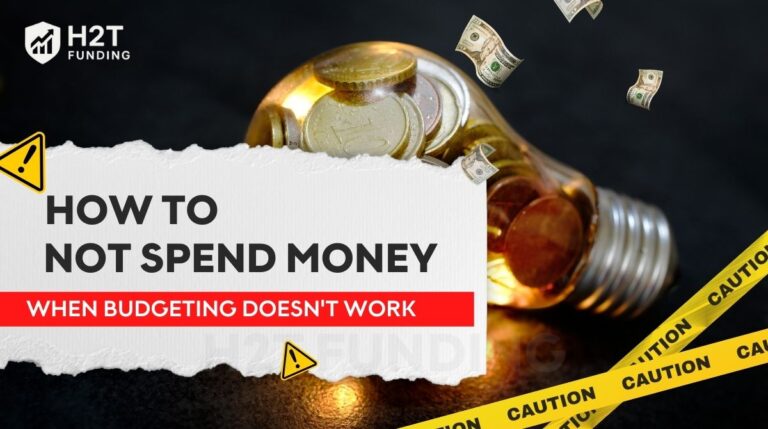Do you feel overwhelmed by your financial situation and think it’s too late to fix it? Feelings of regret, stress, or guilt can make budgeting seem out of reach, especially when you’re already in a tough spot. But you are not alone. Many people delay this simply because they don’t know where to start.
This article by H2T Funding is a practical guide on how to start a budget when its too late, designed to help you regain control, no matter your current situation.
Key takeaways:
- So, how to start a budget when its too late? It’s really a simple roadmap. First, freeze all non-essential spending. Then, get brutally honest about needs vs. wants, tackle urgent bills, map out a 30-day survival budget, and start tracking every dollar.
- But hold on. Before you even touch a calculator, you need the raw data. I’m talking about your actual take-home income, a complete list of your expenses (no secrets!), and the total, unflinching number of your debt. You have to see it to solve it.
- Next, find a system that actually clicks for you. Whether it’s dividing your money into categories with the 50/30/20 rule or using physical cash in envelopes to force discipline, the right tool is the one you’ll stick with.
- And finally, a crucial piece of advice: don’t make this a punishment. Seriously, a budget that makes you miserable is doomed to fail. Small, consistent lifestyle changes will always beat a drastic plan that leads to burnout.
1. First, let’s reset your mindset: It is never too late
Let’s be honest, it’s incredibly easy to feel paralysed when you start comparing your finances to what you see online. Isn’t it? You’re scrolling through social media, and there it is, another person investing, buying a home, or retiring early. It’s so easy to fall into that trap of wondering, How did I get so far behind?

But here’s the actual truth: personal finance isn’t a race. It’s your own personal journey. Your timeline is unique, and any progress you make is a win, even if that progress starts right this second. I think a lot of people get stuck in what’s called analysis paralysis, where they overthink every single financial decision to the point of doing nothing. Then you add a layer of guilt about past mistakes, and it just weighs you down.
Recognising that it’s never too late is the first and most powerful shift you can make. Once you truly accept that, I promise the rest becomes manageable. It frees you up to focus on the details, like figuring out what’s included in the personal care section of a budget, without all that background stress.
2. What you need before starting a late-stage budget
Let’s be brutally honest for a second. Most people don’t fail at budgeting because they’re bad at math. They fail because they’re trying to do it blind, without all the facts. It’s like trying to build a piece of furniture with half the instructions missing. So, before you start stressing about specific budgeting methods or slashing costs, we just need to gather the raw materials.
And I get it. Looking at bank statements can be completely overwhelming. I’ve literally avoided opening my banking app for days just to sidestep that knot of anxiety in my stomach. But we have to rip off that band-aid. You simply cannot fix what you refuse to look at.
So, go grab a coffee, find a quiet corner, and let’s pull together these five things:
- Your real net income: Forget your big annual salary number for a minute. We need the real number that actually lands in your bank account after all taxes and deductions are gone. This is the actual income you have to work with. If your pay is irregular, just look at the last three months and find the average. You can’t make a plan with money you hope to get.
- A no-secrets list of expenses: This is where tracking is everything. Seriously, pull up your bank statements for the last 60 days and get real with yourself. You need to sort your spending into a few clear categories:
- Fixed expenses: These are the predictable bills that rarely change, such as rent, internet, and insurance.
- Variable expenses: This is usually where the money leaks happen. Groceries, gas, eating out… You know the drill.
- Unexpected expenses: Did you get hit with a surprise car repair or a medical bill? Yep, those count too. Write ’em down.
- The full debt picture: Okay, deep breath. This part might sting, but it’s essential. You need to list out every single credit card balance, every personal loan, even that money you owe your family. You have to know the total number to tackle the debt. And honestly? Just seeing the number on paper often makes it feel much less scary than the monster you’ve built up in your head.
- Clear financial goals: Why are you putting yourself through this right now? Is it to finally build an emergency fund? To stop that awful paycheck-to-paycheck cycle? Or just to be able to sleep better at night? Defining your financial goals is the why that will keep you going when this all feels like a chore.
- The right mindset (This is a big one): Finally, and I mean this, leave your guilt at the door. You are not your bank balance. This is not a trial to judge your past mistakes. Think of this as a fact-finding mission. It’s just data. Once you have these real numbers in front of you, the path forward becomes so much clearer.
Think of all this prep work as laying a proper foundation. It might feel messy and uncomfortable right now, but getting these details organised is the only way to build a budget that will actually hold up in the real world. With this data in hand, you’re finally ready to stop guessing and start taking back control.
3. How to start a budget when its too late: A 5-step guide
So, starting a budget this late feels like you’ve already failed, right? Let’s be real, it doesn’t mean that at all. It just means our path forward needs to be crystal clear and maybe a little more aggressive.
Honestly, the best way to get a grip on things is to stop overthinking and start doing. So right now, our focus is dead simple: build a plan around your real income, get ruthless about the tracking of your expenses, and stop the financial bleeding.
Here is the 5-step roadmap to get you back on track:
- Step 1: Stop the financial bleeding (Immediate freeze)
- Step 2: Separate essentials from non-essentials
- Step 3: Identify urgent payments & late bills
- Step 4: Create a 30-day survival plan
- Step 5: Track every dollar strictly
Let’s break it down.
3.1. Step 1: Stop the financial bleeding (Immediate freeze plan)
So, if you’re asking, how do I train myself to stop spending money, the answer for right now is a full-on, immediate spending freeze. I mean it. For the next 48 to 72 hours.
- The rule: The rule is dead simple. You will not spend a single dollar on anything that isn’t absolutely critical to your survival.
- The audit: Log in to your bank account and hunt down every single recurring charge. Those sneaky subscriptions you forgot about? Cancel them. Right now.
- The meal plan: You’re going to slash your food expenses by eating what you already own. For the next 3 to 5 days, get creative with what’s in your fridge and pantry. No grocery runs.

Honestly, this short pause is incredibly powerful. It gives you the mental clarity you need and, more importantly, it stops you from digging the hole any deeper while you figure out your next move.
3.2. Step 2: List your essentials vs. non-essentials
Now, we need to separate your categories into two distinct buckets: what you need to survive and everything else. Be ruthless here.
- Essentials (Needs): Housing, basic groceries, medication, utilities, and transport.
- Non-essentials (Your Wants): This is pretty much everything else. Think dining out, entertainment, daily coffee runs, new clothes, and all those streaming subscriptions.

Look, the 50/30/20 rule is a great guide for this later on. But right now, we’re in ‘survival mode.’ For this month, my strong advice is to cut that ‘wants’ category down to basically zero.
Maybe you need:
3.3. Step 3: Identify urgent payments & late bills
It’s time to gather up every single overdue bill and high-interest debt notice you can find.
- List them out: No more hiding. Write down exactly who you owe and how much is past due. Seeing it on paper is the first step to controlling it.
- Prioritise everything: Your top priorities right now are the Four Walls. Make sure you have housing, food, utilities, and a way to get to work. Everything else can wait.
- Make the call: I know this is tough, but you need to call your service providers. Just say, I’m falling behind. Do you have a hardship program, or is there any chance you could waive the late fees? You would be absolutely amazed at how often they are willing to work with you. You just have to ask.
3.4. Step 4: Create a survival budget for 30 days
With your data ready, focus on how to make a monthly budget for just the next month. Don’t worry about next year yet. Try zero-based budgeting. This method assigns every single dollar a job, whether for rent or debt payoff, until you have $0 left to waste.

To make this stick, try a cash-only experiment. For the next two weeks, withdraw cash for your groceries and gas. When the envelope is empty, you stop spending. Physical cash creates a psychological barrier that digital swiping just doesn’t have.
3.5. Step 5: Track every dollar (and stay on track)
A budget is useless if you don’t follow it. For this first week, you need to track every single purchase, even if it’s just a $1 pack of gum.
Let’s be real for a second: a budget is completely useless if you don’t actually follow it. For this first week, I need you to get a little obsessed with the tracking. I mean every single purchase, even if it’s just a $1 pack of gum. No exceptions.
- Set up weekly check-ins: Seriously, schedule 15 minutes every Sunday just to review your spending. Ask yourself: Did I actually stick to the plan? What needs to change for next week? This is where you make crucial adjustments.
- Find an accountability partner: Tell a trusted friend or partner about your financial goals. It is so much harder to overspend when you know you have to admit it to someone else. That little bit of accountability can make all the difference.
- Boost your income: If the numbers still don’t add up after cutting back, it’s time to look for quick ways to bring in extra cash. Maybe that means selling some stuff you don’t use anymore or picking up a few hours of freelance work.
Honestly, all this tracking helps you see the progress you’re making toward the goals you set. And please, remember this survival mode isn’t forever. Think of it as a temporary bridge to get you back on solid ground and achieve financial stability. Once you’re there, I promise you can switch to a more relaxed system.
Check out additional related articles:
4. Choose a simple budgeting method built for beginners
Once you understand your income, track your spending, and define your essentials, the next step is choosing a budgeting method that supports your day-to-day life. A good system relies on simplicity to give your money structure without making things more stressful.
There are many methods out there, but the best ones for beginners share three things:
- They’re easy to start.
- They offer clear priorities.
- They help you stay consistent.
Let’s explore three proven methods that have helped thousands of people build healthy money habits, starting from scratch.
4.1. The pay-yourself-first method: Prioritise your future self
Here’s how the pay-yourself-first method works, in the simplest terms: the moment you receive income, you immediately move a set amount into savings. You do this before you pay your rent, your bills, or any other expenses. It works no matter where the money comes from, covering the difference between active income and passive income.
What you’re really doing is making your financial future one of your top priorities, not just an afterthought.
And listen, you don’t have to start big. Even if it’s just 1% of your paycheck or $10 a week, the act of doing it builds consistency and creates a feeling of financial safety. I think it gives you an immediate sense of accomplishment, and that feeling is what helps you stick with it.
The best part? You can set up automatic payments through your bank. Let the system do the work for you, and watch your savings grow without you even having to think about it.
4.2. The 50/30/20 rule: A balanced approach to needs, wants, and savings
This method divides your net income into three clear categories:
- 50% for needs: rent or mortgage, groceries, utilities, insurance, transportation.
- 30% for wants: dining out, entertainment, subscriptions, shopping.
- 20% for savings and debt repayment: emergency fund, retirement contributions, and loan payments.

The 50/30/20 rule offers flexibility while keeping your budget grounded in priorities. It’s especially useful if you don’t want to track every single transaction but still want structure.
You can adjust the percentages to fit your current situation. For example, if you’re catching up financially, it’s okay to start with 70/10/20 or 60/20/20. The goal is progress, not perfection.
4.3. The cash envelope system: A physical way to prevent overspending
Let’s talk about a classic method that, honestly, works wonders if you tend to overspend with cards. First, you’ve got to identify your problem categories. You know the ones, groceries, eating out, maybe that’s just for fun, fund that always disappears too fast.
Decide exactly how much you can spend on each for the month. Then, you’re going to withdraw that amount in actual cash and put it into separate, clearly labelled envelopes.
Here’s the beautifully simple rule: you can only use the money in an envelope for its intended purpose. Once an envelope is empty, you’re done spending in that category. Period. No exceptions until the next cycle.
I think this works so well because it adds a real, physical boundary to your spending. Using cash creates a built-in limit that makes your financial decisions feel much more real and mindful. It’s a game-changer.
5. Best money-saving tips when you feel it’s too late to budget
That sinking feeling when you realise you’ve already messed up? Honestly, the first instinct for most of us is either to totally panic or just give up completely.
Oh, I’ve been there. I’ve literally stared at a negative bank balance thinking, What is even the point anymore? But listen, this is the exact moment when the small, simple actions matter the most. It’s not about a miracle. Not at all. We just need to stop the bleeding.
So, here are a few practical things you can do to get your feet back under you, without making your life miserable in the process:
- Implement the 24-hour rule: To be honest, most of us spend money just to feel better. I call this the stress tax. Before making any new financial decisions or purchases that aren’t strictly for survival, force yourself to wait 24 hours. You’ll be surprised how often the urge to buy disappears. This simple pause is the most effective weapon against impulse spending.
- Audit your invisible expenses: You might think you have no money left to save, but tracking your small habits usually proves otherwise. I’m talking about those streaming services you rarely watch or the gym membership you haven’t used since January. When learning how to make a monthly budget, identifying and cutting these vampire costs is often the quickest win. It frees up cash immediately without requiring you to work more hours.
- Shop your pantry first: Before you head to the grocery store this week, challenge yourself to eat what you already have at home. Get creative with that bag of rice or the frozen veggies in the back of the freezer. This isn’t just about saving a few dollars; it’s about making temporary lifestyle changes that drastically lower your weekly expenses. It is a core strategy for how to budget money for low-income effectively.
- Embrace Loud Budgeting: There is no shame in saying, I’m pausing my spending this month. Tell your friends you are low on funds. In my experience, real friends will understand and maybe even suggest a free hangout instead of an expensive dinner. This honesty protects your financial stability and relieves the social pressure to spend money you don’t have.
- Focus on the One-Category fix: If fixing everything feels too heavy, just pick one category, like dining out or clothing, and cut it to zero for 30 days. One of the most helpful budgeting tips for beginners is to start small. You don’t have to be perfect everywhere; you just need to prove to yourself that you can control where your money goes.
To sum it up, saving money when you are late to the game isn’t about punishment. It is about creating just enough breathing room to start fresh.
6. Common mistakes when starting late (and how to fix them)
When you feel like you are racing against the clock to fix your finances, it is easy to panic. I’ve seen so many people try to change their entire life overnight, only to crash and burn a week later. It happens. The pressure to catch up can make us make irrational decisions.
Here are the most common traps I see people fall into, and frankly, how you can avoid them:
The starvation diet approach: Just like crash dieting, cutting your spending to absolute zero rarely works long-term. If you try to eliminate all joy from your life to pay off debt faster, you will eventually snap and binge-spend.
→ The fix: Don’t create a deficit in your happiness just to fix your wallet. Leave a small surplus (even $20) for something you enjoy. It keeps you sane.
Complicating the process: I used to think a good budget needed complex formulas and colour-coded spreadsheets. I was wrong. Poor time management is a huge trap; spending hours setting up a perfect system often leads to burnout before you even start.
→ The fix: Keep your monthly plan boring and simple. If it takes more than 10 minutes to update, it is too complicated.
Forgetting the invisible costs: Most beginners are great at tracking daily costs like food, but forget about irregular expenses like car maintenance or annual subscriptions. These pop up unexpectedly and can ruin your progress instantly.
→ The fix: Review your categories and look back at last year’s bank statements to catch these hidden costs before they catch you.
The all-or-nothing mentality: You overspend by $50, feel guilty, and then abandon the whole plan. Does that sound familiar? We often lack accountability when things go wrong.
→ The fix: Accept that you will mess up. One bad week doesn’t mean you failed; it just means you need to adjust and keep going.
To put it simply, don’t try to be perfect. The goal isn’t to have the prettiest spreadsheet in the world; it is to make progress, no matter how messy it looks at first.
7. FAQs
Start by accepting that it’s not too late. Track your income and expenses, build a survival budget, pick a simple method, and review weekly. The key is taking the first step now, even if it’s small.
Focus on covering essentials first, then list all debts. Choose either the avalanche or snowball method to pay them down. Stay consistent and track your progress.
Track your spending for one week without changing anything. This gives you a clear picture and turns uncertainty into control. It’s the simplest, most powerful first move.
Focus on paying the minimums on everything first to avoid penalties. Then, use any extra money to attack the single debt with the highest interest rate (the avalanche method). This saves you the most money in the long run.
Yes, in fact, you need it the most. Instead of planning for the whole month, try budgeting per paycheck. Match your immediate bill due dates to the specific dates you get paid.
Don’t hide. Call your utility companies or lenders immediately. Many have survival resources or hardship programs to lower payments temporarily, but you have to ask. Prioritise your Four Walls (food, shelter, utilities, transport) before paying anything else.
Forgive yourself. Guilt keeps you stuck in the past, while budgeting is about the future. Think of that wasted money as tuition fees for the financial lesson you are learning right now.
Use whatever you will actually stick with. Personally, I think writing it down on paper makes the numbers feel more real, but apps are better for tracking expenses on the go. There is no right tool, only the one that works for you.
Give it about 90 days. The first month is usually a mess, the second month is for adjustments, and by the third month, the habit usually starts to stick.
Not at all; you are actually early! Starting at 24 puts you miles ahead of someone starting at 30 or 40 because of the power of compound interest. Just start now.
Stop looking at the scary big picture and focus on just the next 7 days. Strip your spending down to the bare essentials and ignore everything else until you stabilise.
It is a popular savings challenge: if you manage to save exactly $27.40 every single day for a year, you will end up with $10,000. You can set up automatic payments to a separate account to make this happen without thinking.
It is possible, but it requires extreme frugality and depends heavily on your location. You would likely need shared housing (roommates), no car payments, and a strict limit on food costs to make the math work.
8. Conclusion
It’s never too late to take back control of your money. Budgeting isn’t about restriction; it’s about freedom, clarity, and how you choose to shape your own future.
Remember, the answer to how to start a budget when its too late isn’t about fixing everything overnight. It’s about starting small, staying consistent, and building a system that works for you. Your financial journey doesn’t depend on your past, but is determined by the step you choose to take today.
Explore more beginner-friendly Budgeting Strategies section at H2T Funding section to keep building your momentum.






